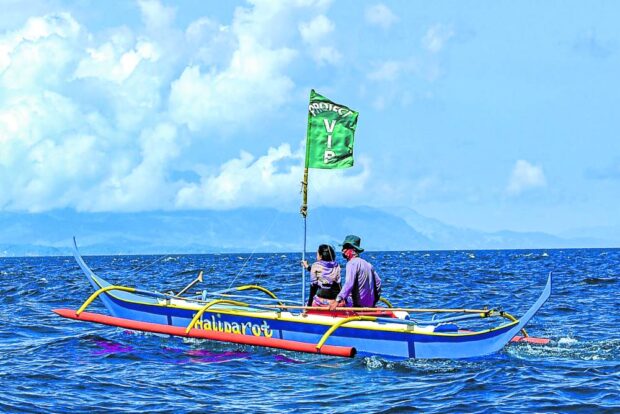DOE’s fossil gas projects in Batangas alarm green group

FOR FUTURE GENERATIONS | A fishing boat used by protesters sails on the waters of Batangas province in this photo posted on the Facebook page of the Center for Energy, Ecology and Development (CEED) on April 22, 2023.
LUCENA CITY, Quezon, Philippines — An environmentalist group has expressed alarm over the growing number of gas-fired power plant projects in Batangas following the completion of two more liquefied natural gas (LNG) facilities in the province.
The Protect the Verde Island Passage (Protect VIP) network was dismayed that the Department of Energy’s (DOE) announcement on the two LNG terminals in Batangas “appears insensitive to the thousands of affected communities who are still reckoning with the oil spill in the Verde Island Passage (VIP),” said Fr. Edwin Gariguez, lead convenor of the group, in a statement on Sunday.
According to Gariguez, the fossil gas projects in Batangas “goes against the need to protect this globally significant marine corridor blessed with incomparable beauty and biodiversity and whose marine wealth provides sustenance and livelihood to millions of Filipinos.”
On June 2, the DOE announced that the completion of the two LNG facilities would “add to and secure the supply of natural gas for its power plants in Batangas.”
The DOE said the first LNG plant, owned by Linseed Field Corp., has started supplying natural gas to the Ilijan Natural Gas Power Plant, located in Barangay Ilijan in Batangas City.
Another facility built by FGEN LNG Corp. (FGEN LNG) in Batangas City would be delivering its first LNG cargo in the later part of this year, the DOE added.
The FGEN LNG terminal inside its First Gen Clean Energy Complex in Batangas aims to supply the power needs of gas-fired plants in the country, mainly within the Luzon grid.
Untapped energy sources
But Gariguez said the numerous fossil gas projects in Batangas could mean “more shipping lane traffic in the VIP and more toxic cargo plying our waters,” endangering the resource-rich passage, similar to what happened on Feb. 28 when oil tanker MT Princess Empress, which was carrying 800,000 liters of industrial fuel, sank off the waters of Oriental Mindoro, which is within the VIP corridor, and caused a massive oil spill.
“DOE’s pursuit of new energy sources must not come at the expense of our environment and people, specifically when we are teeming with abundant renewable energy sources waiting to be tapped,” he emphasized.
VIP is a 1.14 million-hectare marine ecosystem located off the coastlines of Batangas, Romblon, Marinduque, Occidental Mindoro and Oriental Mindoro provinces. It has been recognized as the “center of global shorefish biodiversity” due to the high densities of marine resources in the area.
Fragile marine corridor
Protect VIP described the fragile marine corridor as also the “epicenter” of fossil gas and LNG developments in the country, as eight of 27 proposed new plants and seven of the nine planned LNG terminals in the country are located in Batangas.
The group warned that by allowing fossil gas facilities to be built and operated, it will expose the VIP to the frequent entry of LNG barges, and inadvertent oil spills or disposal of shipboard liquid wastes and bilge water.
“The VIP is also currently grappling with an oil spill catastrophe, now nearing its third month with still no clear accountability and liability from responsible actors,” the group emphasized.
Large amounts of oil sludge from MT Princess Empress found their way into the coastal waters and shores of Oriental Mindoro and had even reached as far as Caluya Islands in Antique, Taytay in Palawan and some parts of Batangas.
Protect VIP has been demanding that the government should include VIP in the list of protected areas under the Expanded National Integrated Protected Areas System Act of 2018 to shield it from “destructive human exploitation.”


















